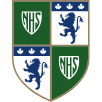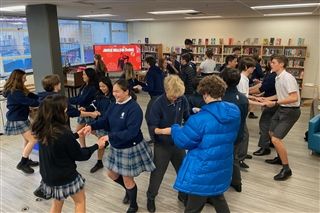Literature with Ms. Jamie Elbert is always fun, but this time students were in for an awesome 1920s-style surprise! As many may know, it is not an easy feat to organize a party, but Ms. Elbert and Ms. Lee were able to throw a party reminiscent of the 1920s (and one that could rival Mr. Gatsby’s, for those who have read F. Scott Fitzgerald’s novel The Great Gatsby), with the same level of enthusiasm, energy, sparkliness, and extravagance!
It kicked off with a mass game of Gimkit, a live learning game show featuring Ms Elbert’s extensive list of literary terms and the chance to pelt peers with digital snowballs.. Literature students become very familiar with these literary devices. They are an important strand of the assessments, as the analysis of these literary devices in selected works highlight a student’s thematic skills.
This was followed by a swing lesson from Ms. Elbert herself. Well-versed in the art of dance, Ms. Elbert educated the class on how to swing dance as people did in 1920. It was a fun-filled experience, where students got a good workout as well as a lesson on the history and significance of “the Jazz Age.”Some students had already learned both waltz and swing steps in Grade 9 during a study of poetic rhythms and were happy to revisit their skills in the new analytical contexts of style and theme, class and privilege, personal expression and cultural moments. Ms Elbert loves any opportunity to get students stepping to the beat!
It might seem pretty self-explanatory—after all who wouldn’t choose a fun-filled class—but we asked HL Lit students Meredith Gould ’24, Sophie Davies ’24, and Polina Skrigitil ‘24 why they chose to take IB English Literature HL.
“I chose IB Lit because I love to read and compare and contrast texts,” said Meredith “Plus, Ms. Elbert!”
“I really like books,” replied Sophie. “I read a lot in my free time, so having a class where all we talk about is books was pretty much a given that I would take.”
“I wanted to explore various texts in greater detail and have the opportunity to discuss them with my peers,” answered Polina.
After raising their glasses in a series of creative toasts to their favourite characters, the students were tasked with comparing two movie adaptations of The Great Gatsby—David Merrick’s 1974 version and Baz Luhrmann’s 2013 version. Analyzing film and media is an integral part of IB English Language and Literature curriculum, but it is not as prominent in IB English Literature, which focuses more on the analysis of literary forms: poetry, prose, and plays. This is something that IB English Literature HL students noticed differed from the MYP curriculum as well.
Meredith pointed out, “There is less focus towards movies, videos, etc., and more towards actual literature and texts in other languages.”
“In DP Lit, more time is spent focusing on a single text/topic than in the MYP curriculum. This allows for a more thorough study and deeper analysis of a text!” says Polina.
Over two years, students in IB English Literature HL study a selection of acclaimed works, including Margaret Atwood’s Penelopiad, Sophocles’ Antigone, F. Scott Fitzgerald’s The Great Gatsby, Neil Gaiman’s Good Omens, Jean-Paul Sartre’s No Exit, Marjane Satrapi’s Persepolis, and many other poems and works.
Extensive analysis is a key part of the course and something many students enjoy, as Sophie describes, “I love when as a class we dive into a single passage or poem super in-depth.”
So far, The Great Gatsby has been the class favourite.
“So far, I have loved the waltzing, but mainly studying Gatsby because I love the book,” says Meredith. “and it’s so fun to learn about the Roaring Twenties.”
These works are carefully selected to focus on literary forms of poetry, prose (fiction and non-fiction), and drama. Over the course of two years, IB English Literature HL students will have four assessments: an Individual Oral, HL Essay, Paper 1 Exam, and Paper 2 Exam, which account for 20%, 20%, 35%, and 25% respectively of their mark. SL students are required to complete an Individual Oral, Paper 1 Exam, and Paper 2 Exam, worth 30%, 35%, and 35% respectively of their mark.
At first, the scope of the curriculum covered by this course may seem incredibly ambitious and stressful. In the more-than-capable hands of the GNS Language department, however, students will not only flourish, but they will also develop a lifelong love of literature.





